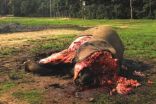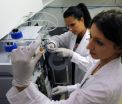(Press-News.org) Stroke hospitalization and death rates may rise and fall with changes in environmental temperature and dew point, according to research presented at the American Stroke Association's International Stroke Conference 2014.
"Weather is not something people would typically associate with stroke risk; however, we've found weather conditions are among the multiple factors that are associated with stroke hospitalizations," said Judith H. Lichtman, Ph.D., M.P.H., study author and an associate professor in Epidemiology at the Yale School of Public Health in New Haven, Conn.
Researchers identified a nationwide sample of 134,510 people, 18 years and older, admitted to hospitals in 2009-10 for ischemic stroke (caused by a blood clot that blocks blood flow in or leading to the brain). They then obtained temperature and dew point data during that period.
They found:
Larger daily temperature changes and higher average dew point (indicating higher air moisture) were associated with higher stroke hospitalization rates. Lower average annual temperatures were associated with stroke hospitalizations and death.
With each 1°F increase in average temperature, there was a 0.86 percent decrease in the odds of stroke hospitalization and a 1.1 percent decrease in the odds of dying in the hospital after stroke.
Increases in daily temperature fluctuation and average dew point were associated with increased odds of stroke hospitalization, but not with dying in the hospital.
"This study suggests that meteorological factors such as daily fluctuations in temperature and increased humidity may be stressors that increase stroke hospitalizations," Lichtman said. "People at risk for stroke may want to avoid being exposed to significant temperature changes and high dew point and, as always, be prepared to act quickly if they or someone they know experiences stroke signs and symptoms.
"Future research is needed to better understand the cause and effect of changes in weather conditions, as well as to explore potential mechanisms for this association."
Stroke risk factors that can be changed, treated or controlled include: high blood pressure; cigarette smoking; diabetes; carotid or other artery disease; peripheral artery disease; atrial fibrillation; other heart disease; sickle cell disease; high blood cholesterol; poor diet; physical inactivity; obesity; and excessive alcohol consumption.
Stroke signs and symptoms are facial drooping, arm weakness, speech difficulty, sudden numbness or weakness of the leg, arm or face, sudden confusion or trouble understanding, sudden trouble seeing in one or both eyes, sudden trouble walking, dizziness, loss of balance or coordination, and sudden severe headache with no known cause.
INFORMATION:
Co-authors are: Erica C. Leifheit-Limson, Ph.D., and Larry B. Goldstein, M.D. Author disclosures are on the abstract.
The study was funded by the Yale School of Public Health.
Downloadable video/audio interviews, B-roll, animation and images related to this news release are on the right column of the release link at http://newsroom.heart.org/news/weather-changes-may-be-linked-with-stroke-hospitalization-death?preview=273de91220c0c2edf4757f79e18ff19d. Video clips with researchers/authors of the studies will be added to the release link after embargo.
Follow news from ASA International Stroke Conference 2014 via Twitter: @HeartNews #ISC14.
Statements and conclusions of study authors that are presented at American Stroke Association scientific meetings are solely those of the study authors and do not necessarily reflect association policy or position. The association makes no representation or warranty as to their accuracy or reliability. The association receives funding primarily from individuals; foundations and corporations (including pharmaceutical, device manufacturers and other companies) also make donations and fund specific association programs and events. The association has strict policies to prevent these relationships from influencing the science content. Revenues from pharmaceutical and device corporations are available at http://www.heart.org/corporatefunding.
Note: Actual presentation is 6:15 p.m. PT Wednesday, Feb. 12, 2014.
Weather changes may be linked with stroke hospitalization, death
Abstract: WP123 (Room Hall G)
2014-02-12
ELSE PRESS RELEASES FROM THIS DATE:
Lost and found: New beetle collected by Darwin 180 years ago published on his birthday
2014-02-12
In 1832 Charles Darwin disembarked from HMS Beagle in Bahia Blanca, Argentina where he travelled by land to Buenos Aires. In Bahia Blanca, Darwin collected several fossils of large mammals along with many other living organisms, including several insects. More than 180 years later on Darwin's birthday, February 12, scientists name after him a long lost but new to science beetle genus and species from this collection.
The beetle was discovered and described by Dr. Stylianos Chatzimanolis, an entomologist at the University of Tennessee at Chattanooga, USA as a new genus ...
Use of mortality as measure of stroke care questioned
2014-02-12
A new study disputes the effectiveness of mortality as a measure of the quality of care provided by hospitals to stroke patients. The paper – which was simultaneously presented today at the International Stroke Conference in San Diego and published in the journal Stroke – found that use of do-not-resuscitate (DNR) orders differ widely between hospitals and that this variation can significantly skew a hospital's quality "ranking" based on mortality.
"With mortality increasingly being used as a marker for the quality of care provided to stroke patients, it is essential ...
"You hide it -- I'll find it!" -- Great tit has a bird's eye view when looking for dinner
2014-02-12
Birds that hoard food for a rainy day better be sure that there are no great tits around to spy on where they hide their reserve of seeds and nuts. So says Anders Brodin and Utku Urhan of the University of Lund in Sweden, who found that great tits can remember the position of such hideaways up to 24 hours after seeing it cached. Interestingly, even though great tits share this mental ability with well-known hoarders such as crows and jays, they do not store up food themselves. The findings appear in Springer's journal Behavioral Ecology and Sociobiology.
Observations ...
New data shows continued decline of African forest elephants
2014-02-12
London (February 12, 2014)—New data from the field in Central Africa shows that between 2002 and 2013, 65 percent of forest elephants were killed. They are being poached, for their ivory, at a shocking 9 percent per year.
This new data marks an update to an earlier paper in the online journal PLOS ONE on the status of forest elephants across Central Africa, published by the same scientists. Many organisations collaborated in the study which covered 80 sites, in five countries, over the twelve years of data collection.
The earlier paper, published in 2013, already had ...
Capillaries will measure diffusion and help in more efficient medical treatment
2014-02-12
How strongly do two dissolved analytes react with each other? Such information is of paramount importance not only in chemistry and molecular biology, but also in medicine or pharmacy, where it is used, i.a., to determine optimal drug doses. A method developed in the Institute of Physical Chemistry of the Polish Academy of Sciences in Warsaw will allow for determining diffusion coefficients of analytes in fluids and equilibrium constants of reactions – quickly, at low cost, and most importantly: universally.
In many medical therapies, a prerequisite for efficient treatment ...
Genetic find might lead to cattle that are more resistant to TB
2014-02-12
Scientists have identified genetic traits in cattle that might allow farmers to breed livestock with increased resistance to bovine tuberculosis (TB).
The study, which compared the genetic code of TB-infected animals with that of disease-free cattle, could help to impact on a disease that leads to major economic losses worldwide.
The research, led by the University of Edinburgh's Roslin Institute, has identified a number of genetic signatures associated with TB resistance in the cows that remained unaffected.
The study builds on previous research by The Roslin Institute, ...
Mindfulness meditation may improve decision making
2014-02-12
One 15-minute focused-breathing meditation may help people make smarter choices, according to new research from researchers at INSEAD and The Wharton School. The findings are published in the February issue of Psychological Science, a journal of the Association for Psychological Science.
People have trouble cutting their losses: They hold on to losing stocks too long, they stay in bad relationships, and they continue to eat large restaurant meals even when they're full. This behavior, often described as "throwing good money after bad," is driven by what behavioral scientists ...
Scientists discover a new pathway for fear deep within the brain
2014-02-12
Cold Spring Harbor, NY – Fear is primal. In the wild, it serves as a protective mechanism, allowing animals to avoid predators or other perceived threats. For humans, fear is much more complex. A normal amount keeps us safe from danger. But in extreme cases, like post-traumatic stress disorder (PTSD), too much fear can prevent people from living healthy, productive lives. Researchers are actively working to understand how the brain translates fear into action. Today, scientists at Cold Spring Harbor Laboratory (CSHL) announce the discovery of a new neural circuit in the ...
Poaching threatens savannah ecosystems
2014-02-12
White rhinoceros may be extinct in twenty years with the current poaching rates. The loss of this megaherbivore is in itself a tragedy, but it may also have tremendous effects on the ecosystems they now live in.
The white rhino (Ceratotherium simum), and other megaherbivores, are key drivers of ecosystem functioning because they´re not controlled by predation.
A new study by Joris Cromsigt and Mariska te Beest, published in Journal of Ecology, highlights the role of the white rhino in the savannah ecosystems.
Earlier empirical studies on the ecosystem impact of megaherbivores ...
Exercise targets cellular powerhouses to improve heart function
2014-02-12
Whether lifting weights in a gym or just walking around the block, exercise has many benefits, such as helping people lose weight and build stronger muscles. Some studies suggest that it may reduce the risk of developing cancer and other diseases. Researchers now report in ACS' Journal of Proteome Research that moderate, long-term physical activity appears to improve cardiovascular health in mice by targeting the heart cells' powerhouses — the mitochondria.
Eduard Sabidó, Francisco Amado and colleagues explain that despite the well-documented benefits of exercise, the ...
LAST 30 PRESS RELEASES:
Strategic river sensors could have forewarned of Texas Camp flood disaster
Drone sampling of whale breath reveals first evidence of potentially deadly virus in Arctic
Roman soldiers defending Hadrian’s Wall infected by parasites, study finds
Pinochet’s prisoners were tormented with music but still found solace in it, a new book reveals
Fertility remains high in rural Tanzania despite access to family planning
AI-assisted device can improve autism care access
Kinetic careers
Uncovering how parasitic plants avoid attacking themselves to improve crop resistance
Nanoparticle vaccine strategy could protect against Ebola and other deadly filoviruses
Study finds brain care score can predict risk of stroke across racial groups
Key lung immune cells can intensify allergic reactions
Do hormones explain why women experience more gut pain?
New materials conduct ions in solids as easily as in liquids
Breakthrough of the Year: Renewable energy begins to eclipse fossil fuel-based sources
LLM use is reshaping scientific enterprise by increasing output, reducing quality and more
Introducing LightGen, a chip for ultra-fast, ultra-efficient generative AI
Astronomers see fireworks from violent collisions around nearby star
ACC/AHA issue new guideline on managing congenital heart disease in adults
Cosmic crash caught on camera
Is talented youth nurtured the wrong way? New study shows: top performers develop differently than assumed
Ants: An untapped resource in the development of antibiotics?
Archaeologists use AI to create prehistoric video game
Mitochondria migrate toward the cell membrane in response to high glucose levels
Tiny viral switch offers hope against drug-resistant bacteria
Most parents aware of early peanut introduction guidelines, but confused about details
HPV vaccine can protect against severe lesions of the vulva and vagina
Virtual care provision and emergency department use among children and youth
Quadrivalent HPV vaccine and high-grade vulvovaginal lesions
Insights into dry eyes gained from stem cell-derived tear glands
Researchers identify 166 human pluripotent stem cell lines available for use in clinical applications
[Press-News.org] Weather changes may be linked with stroke hospitalization, deathAbstract: WP123 (Room Hall G)




